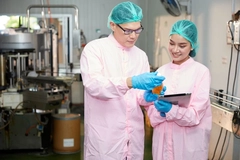Infant nutrition (part 1): Challenges in feeding the first 1,000 days
.jpg)
18 Jun 2018 --- The World Health Organization (WHO) solidly recommends breastfeeding for infants. However, there are situations – medical, situational or personal – that necessitate good quality breast milk substitutes (BMS), such as formulas. In a bid to produce a formula that is closest in composition to human breast milk, manufacturers face a range of unique R&D challenges. In this two-part series on Infant Nutrition, NutritionInsight speaks to a number of key suppliers and experts about these challenges.
“The concept of the first 1000 days originated because we realized the time from conception to the second birthday (1000 days) is so important as growth during this period is faster and more important than the rest of life. This is also because of the development of important organs, such as the brain at this time. The brains grows in the first year of life on a very steep curve. Also, the immune system is being primed after birth in this very critical window,” Gigi Veerenman, Professor of Pediatric Gastroenterology at the Free University Brussels tells NutritionInsight.
Emerging science has demonstrated how early nutrition can program the immediate and long-term health of an infant. “Nutrients are regulators of the immune system and not having enough of a nutrient can lead to lower immunity,” Charlotte Beyerholm, Senior Marketing Manager at Chr. Hansen tells NutritionInsight.
The easiest way to deliver these essential nutrients to an infant is through breastfeeding, or, formula that provides similar qualities, Beyerholm explains.
As human breast milk is the gold standard for formula, researchers look to the composition of breast milk as a model to emulate. However, “this is where many challenges lie as a mother’s milk is very unique to her and it changes over time,” Sandra Einerhand, Founder of Einerhand Science & Innovation and Consultant in Strategy and Innovation in Nutrition and Health, tells NutritionInsight.
Breast milk is best
“Human milk composition is complex and differs in time and between individuals so how can we mimic that gold standard? Infant formulas have improved considerably over time, but there is still quite some room for further improvement on the composition,” says Einerhand.
One of the most significant discoveries in recent years has been Human Milk Oligosaccharides (HMOs) which are “the third most abundant ingredient in human milk” Yolanda Roescher, Marketing Communications Manager at FrieslandCampina, tells NutritionInsight.
“Now, after many years of research we are now able to produce the most abundant HMO 2-FL in an identical structure for infant nutrition,” adds Roescher.
Indeed, Einerhand notes that some companies are launching products containing HMOs, which is an excellent step for the infant formula market, yet, “if you look at HMOs in human milk, it is not just one molecule or one HMO, it’s actually a couple of hundred.”

Einerhand Science & Innovation
and Consultant in Strategy and Innovation in
Nutrition and Health
NutritionInsight has reported on widely on the on-going HMO launches in the formula market, including Dupont attaining a US green light on its HMO, FrieslandCampina attaining EU approval and GRAS status and DuPont and Inbiose's EU regulatory approval of their human milk oligosaccharide ingredient.
“Some companies are working on producing more complex ones – up to ten – and there are even companies trying to produce more than a hundred complex HMO mimics. I see this trend of trying to introduce even more complex HMOs growing,” she adds.
And of course, even if hundreds of HMOs are mimicked in formula, a total copy of human milk will not yet be achieved. For example, companies add protein to their formulas, but to completely simulate human milk, the protein concentration would have to change over time. Just after birth the concentration of protein in breast milk is very high but decreases over time, to match the baby’s needs. Today, this is partly addressed in formulas directed at different infant stages. Furthermore, membrane-coated milk fat droplets that are highly present in breast milk must also be emulated in formula, but this will be considered further in part two of the infant nutrition series.
Clinical difficulties and proving benefits
In any segment of nutrition, clinical trials will play an important role as people’s health and well-being are in question. When it comes to infants, it can be particularly difficult to not only prove findings but to even find participants in the first place.
In this way, many ethical concerns surround trials involving infants. As Einerhand notes, “no one wants to put a needle in an infant if there is no need for it.”
Ethical concerns around consent are also high, leading to difficulties in gaining approval. It can be easier to conduct trials among pre-term babies who often reside in the hospital for some time and are already being closely monitored.
This also translates into companies facing difficulties when trying to prove – front of pack – the benefits that their products may bring, for example, “improves digestive comfort” or “decreases allergy risk.” “The clinical substantiation of such benefits is a long-term, costly process,” Einerhand adds.

Safety regulations around formula and Breast Milk Substitute marketing laws
When intending to supply new-born baby products, “production is subjected to draconian quality requirements,” Marie Blondel, Marketing Communications Manager Europe at Roquette tells NutritionInsight. “The level of food safety needed for this industry is increasing, regulatory standards and quality requirements are strengthening yearly.”
This has not come as a detriment, however, to the growing infant formula market. According to Innova Market Insights data, global tracked infant formula launches saw a compound annual growth rate (CAGR) of 32 percent between 2012 and 2016. The CAGR value for global baby formula/milk sales is estimated to be 8.6 percent between 2015 and 2017.
Consumer trust could be one facet driving strict safety regulations, in light of some very high-profile scandals, such as the 2008 Chinese infant formula safety scandal, where melamine contamination was found in a range of products.
Moreover, once infant formula has passed strict food safety procedures, marketing recommendations around BMS are also stringent. To encourage as many women as possible to breastfeed until an infant is at least six months old, the WHO regulates the promotion of BMS, instead advocating that mothers can make the best feeding choices through access to impartial, adequate information that is free from commercial influences. The inappropriate marketing of BMS may negatively affect choice and ability of a mother to breastfeed her infant.

with the International Code of
Marketing of Breast-milk Substitutes.
Access to Nutrition Index.
The effects of inadequate nutrition through some types of BMS is said to result in the deaths of 800,000 child deaths annually, according to WHO, and this number could potentially be reduced if all unnecessary and misleading marketing could be avoided. The Access to Nutrition Index ranks the top food and beverage companies on their commitment to the WHO guidelines. However, this year’s results show there is still a widespread lack of compliance.
Friesland Campina was among the companies ranked, and Godert Zijlstra, Business Development Director tells NutritionInsight about the companies supportive stance: “FrieslandCampina supports the WHO’s recommendation for exclusive breastfeeding for the first six months of life and continued breastfeeding along with the introduction of safe and appropriate complementary feeding up to two years of age or beyond. We are committed to adhering to the aim and principles of the WHO International Code of Marketing of Breast Milk Substitutes and subsequent relevant WHA Resolutions.”
BMS options are increasingly similar to human milk and can offer those caring for children, who cannot breastfeed, many benefits and sound nutrition. However, there are undoubtedly many hurdles facing manufacturers, from development to production and lastly, marketing. Part two of this special report series on infant nutrition will focus on significant innovations in the market and R&D.
Part two of the infant nutrition series focuses on innovations in the market.
By Laxmi Haigh












